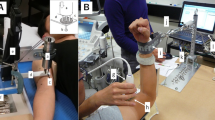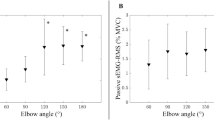Abstract
Purpose
Since experimental techniques classically used to investigate the mechanical behavior of muscle in vivo assess global mechanical properties of the musculo-articular complex, the aim of the present study was to assess the feasibility and reliability of localized contracting biceps brachii elastic properties’ measurements using elastography.
Methods
Twelve subjects participated in intra-session, inter-session and inter-observer reliability experiments. They were asked to perform a linear torque ramp of 30 s from 0 to 75 % of maximal voluntary contraction. Joint torque, electromyographic (EMG) activity and shear elastic modulus were synchronously measured in the biceps brachii. Elastic properties were determined by stiffness indexes calculated as the slopes of the linear regressions established between shear modulus and joint torque or EMG levels. Compliance indexes were also obtained by plotting logarithmic values of shear modulus versus torque or EMG.
Results
Determination coefficients were high for the four relationships (0.87–0.94). In addition, reliability was significantly higher for the compliance index taking into account logarithmic values of EMG activity (mean coefficient of variation of 5.3 ± 4.1 %; P = 0.003). Although not statistically different from other methods (P = 0.111), the mean intra-class correlation coefficient was excellent (0.98 ± 0.01) and the standard error in measurement very low (0.04 ± 0.01 for a mean index of −0.73 ± 0.28).
Conclusions
Biceps brachii elastic properties can be reliably investigated during contraction via elastography using the proposed fitting method. Use of this technique could provide new insights into the understanding of localized muscle elastic properties adaptations.



Similar content being viewed by others
Abbreviations
- CI:
-
Compliance index
- CV:
-
Coefficient of variation
- EMG:
-
Electromyographic
- ICC:
-
Intra-class correlation coefficient
- MVC:
-
Maximal voluntary contraction
- RMS:
-
Root mean square
- SEC:
-
Series elastic component
- SEM:
-
Standard error in measurement
- SI:
-
Stiffness index
- SSI:
-
Supersonic shear wave imaging
References
Bercoff J, Tanter M, Fink M (2004) Supersonic shear imaging: a new technique for soft tissue elasticity mapping. IEEE Trans Ultrason Ferroelectr Freq Control 51(4):396–409
Bosco C, Tihanyi J, Komi PV, Fekete G, Apor P (1982) Store and recoil of elastic energy in slow and fast types of human skeletal muscles. Acta Physiol Scand 116(4):343–349. doi:10.1111/j.1748-1716.1982.tb07152.x
Bouillard K, Nordez A, Hug F (2011) Estimation of individual muscle force using elastography. PLoS One 6(12):e29261. doi:10.1371/journal.pone.0029261
Bouillard K, Hug F, Guevel A, Nordez A (2012a) Shear elastic modulus can be used to estimate an index of individual muscle force during a submaximal isometric fatiguing contraction. J Appl Physiol 113(9):1353–1361. doi:10.1152/japplphysiol.00858.2012
Bouillard K, Nordez A, Hodges PW, Cornu C, Hug F (2012b) Evidence of changes in load sharing during isometric elbow flexion with ramped torque. J Biomech 45(8):1424–1429. doi:10.1016/j.jbiomech.2012.02.020
Cornu C, Goubel F (2001) Musculo-tendinous and joint elastic characteristics during elbow flexion in children. Clin Biomech (Bristol, Avon) 16(9):758–764
Cornu C, Goubel F, Fardeau M (1998) Stiffness of knee extensors in Duchenne muscular dystrophy. Muscle Nerve 21(12):1772–1774
Cornu C, Maisetti O, Ledoux I (2003) Muscle elastic properties during wrist flexion and extension in healthy sedentary subjects and volley-ball players. Int J Sports Med 24(4):277–284. doi:10.1055/s-2003-39500
Doheny EP, Lowery MM, Fitzpatrick DP, O’Malley MJ (2008) Effect of elbow joint angle on force-EMG relationships in human elbow flexor and extensor muscles. J Electromyogr Kinesiol 18(5):760–770. doi:10.1016/j.jelekin.2007.03.006
Drakonaki EE, Allen GM, Wilson DJ (2012) Ultrasound elastography for musculoskeletal applications. Br J Radiol 85(1019):1435–1445. doi:10.1259/bjr/93042867
Enoka RM, Duchateau J (2008) Muscle fatigue: what, why and how it influences muscle function. J Physiol 586(1):11–23. doi:10.1113/jphysiol.2007.139477
Foure A, Nordez A, Cornu C (2010) In vivo assessment of both active and passive parts of the plantarflexors series elastic component stiffness using the alpha method: a reliability study. Int J Sports Med 31(1):51–57. doi:10.1055/s-0029-1241210
Foure A, Nordez A, McNair P, Cornu C (2011) Effects of plyometric training on both active and passive parts of the plantarflexors series elastic component stiffness of muscle-tendon complex. Eur J Appl Physiol 111(3):539–548. doi:10.1007/s00421-010-1667-4
Gennisson JL, Catheline S, Chaffai S, Fink M (2003) Transient elastography in anisotropic medium: application to the measurement of slow and fast shear wave speeds in muscles. J Acoust Soc Am 114(1):536–541
Gennisson JL, Cornu C, Catheline S, Fink M, Portero P (2005) Human muscle hardness assessment during incremental isometric contraction using transient elastography. J Biomech 38(7):1543–1550. doi:10.1016/j.jbiomech.2004.07.013
Grosset JF, Lapole T, Mora I, Verhaeghe M, Doutrellot PL, Perot C (2010) Follow-up of ankle stiffness and electromechanical delay in immobilized children: three cases studies. J Electromyogr Kinesiol 20(4):642–647. doi:10.1016/j.jelekin.2010.02.003
Hill AV (1938) The heat of the shortening and the dynamic constants of muscle. Proc R Soc B 126:136–195
Hopkins WG (2000) Measures of reliability in sports medicine and science. Sports Med 30(1):1–15
Huxley AF, Simmons RM (1971) Mechanical properties of the cross-bridges of frog striated muscle. J Physiol 218(Suppl):59P–60P
Keenan KG, Farina D, Maluf KS, Merletti R, Enoka RM (2005) Influence of amplitude cancellation on the simulated surface electromyogram. J Appl Physiol 98(1):120–131. doi:10.1152/japplphysiol.00894.2004
Komi PV (1984) Physiological and biomechanical correlates of muscle function: effects of muscle structure and stretch-shortening cycle on force and speed. Exerc Sport Sci Rev 12:81–121
Lacourpaille L, Hug F, Bouillard K, Hogrel JY, Nordez A (2012) Supersonic shear imaging provides a reliable measurement of resting muscle shear elastic modulus. Physiol Meas 33(3):N19–N28. doi:10.1088/0967-3334/33/3/N19
Lambertz D, Pérot C, Kaspranski R, Goubel F (2001) Effects of long-term spaceflight on mechanical properties of muscles in humans. J Appl Physiol 90(1):179–188
Lambertz D, Mora I, Grosset JF, Pérot C (2003) Evaluation of musculotendinous stiffness in prepubertal children and adults, taking into account muscle activity. J Appl Physiol 95(1):64–72
Lambertz D, Souza TO, Canon F, Xavier LC, Ferraz KM (2013) Influence of overweight on the active and the passive fraction of the plantar flexors series elastic component in prepubertal children. J Appl Physiol 114(1):73–80. doi:10.1152/japplphysiol.00241.2012
Lapole T, Pérot C (2011) Effects of repeated Achilles tendon vibration on triceps surae stiffness and reflex excitability. J Electromyogr Kinesiol 21(1):87–94
Magnusson SP, Narici MV, Maganaris CN, Kjaer M (2008) Human tendon behaviour and adaptation, in vivo. J Physiol 586(1):71–81. doi:10.1113/jphysiol.2007.139105
Michaut A, Pousson M, Ballay Y, Van Hoecke J (2001) Short-term changes in the series elastic component after an acute eccentric exercise of the elbow flexors. Eur J Appl Physiol 84(6):569–574
Nordez A, Hug F (2010) Muscle shear elastic modulus measured using supersonic shear imaging is highly related to muscle activity level. J Appl Physiol 108(5):1389–1394. doi:10.1152/japplphysiol.01323.2009
Pearson SJ, McMahon J (2012) Lower limb mechanical properties: determining factors and implications for performance. Sports Med 42(11):929–940. doi:10.2165/11635110-000000000-00000
Pousson M, Van Hoecke J, Goubel F (1990) Changes in elastic characteristics of human muscle induced by eccentric exercise. J Biomech 23(4):343–348
Sasaki K, Toyama S, Ishii N (2014) Length-force characteristics of in vivo human muscle reflected by supersonic shear imaging. J Appl Physiol 117(2):153–162. doi:10.1152/japplphysiol.01058.2013
Shorten MR (1987) Muscle elasticity and human performance. In: Van Gheluwe B, Atha J (eds). Current Research in Sports Biomechanics. Karger, Basel, pp 1–18
Tanter M, Bercoff J, Athanasiou A, Deffieux T, Gennisson JL, Montaldo G, Muller M, Tardivon A, Fink M (2008) Quantitative assessment of breast lesion viscoelasticity: initial clinical results using supersonic shear imaging. Ultrasound Med Biol 34(9):1373–1386. doi:10.1016/j.ultrasmedbio.2008.02.002
Valour D, Pousson M (2003) Compliance changes of the series elastic component of elbow flexor muscles with age in humans. Pflugers Arch 445(6):721–727. doi:10.1007/s00424-002-0871-4
Vigreux B, Cnockaert JC, Pertuzon E (1980) Effects of fatigue on the series elastic component of human muscle. Eur J Appl Physiol Occup Physiol 45(1):11–17
Yoshitake Y, Takai Y, Kanehisa H, Shinohara M (2013) Muscle shear modulus measured with ultrasound shear-wave elastography across a wide range of contraction intensity. Muscle Nerve. doi:10.1002/mus.24104
Acknowledgments
The authors thank John Temesi for revision of the English throughout the manuscript.
Author information
Authors and Affiliations
Corresponding author
Additional information
Communicated by Olivier Seynnes.
Rights and permissions
About this article
Cite this article
Lapole, T., Tindel, J., Galy, R. et al. Contracting biceps brachii elastic properties can be reliably characterized using supersonic shear imaging. Eur J Appl Physiol 115, 497–505 (2015). https://doi.org/10.1007/s00421-014-3037-0
Received:
Accepted:
Published:
Issue Date:
DOI: https://doi.org/10.1007/s00421-014-3037-0




